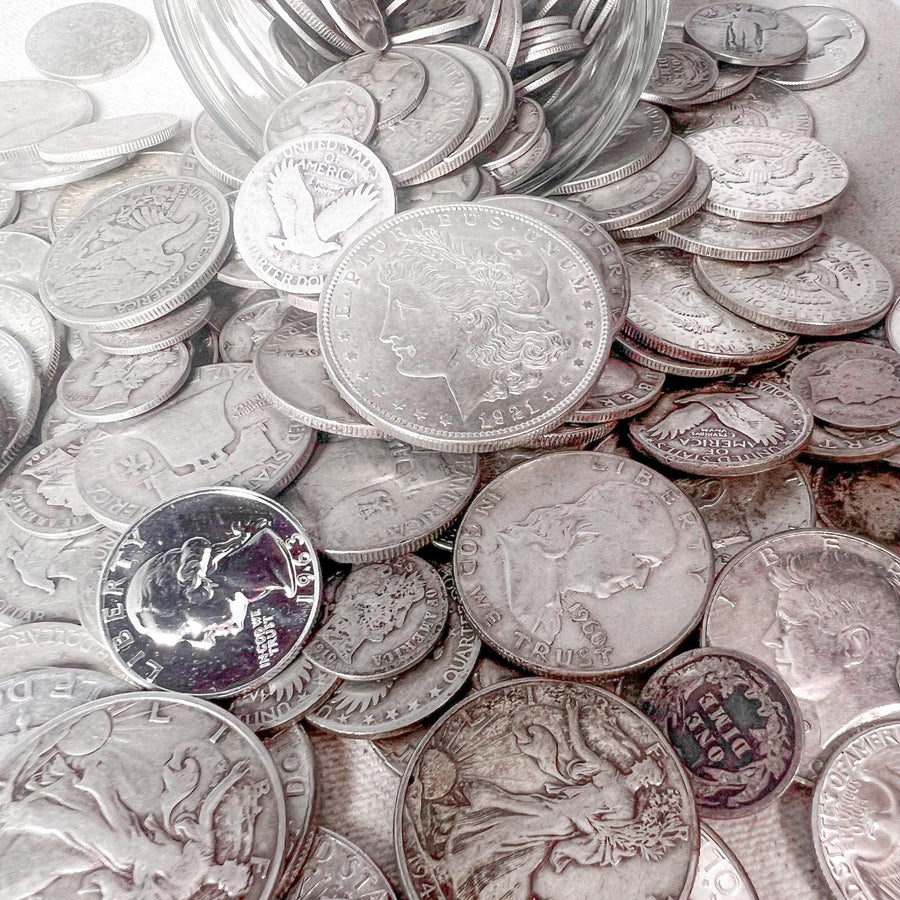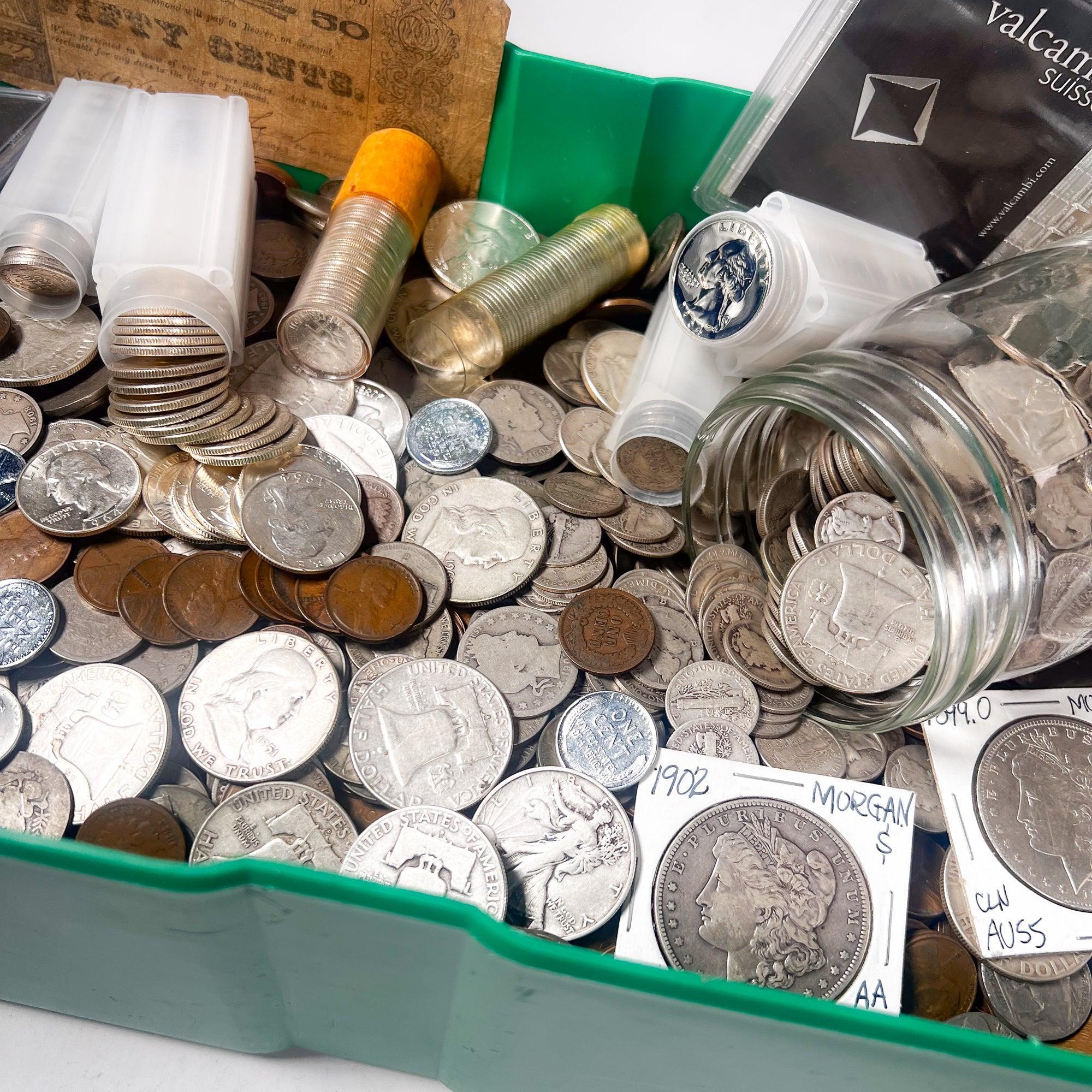Investing in Morgan Silver Dollars: Strategies for Profit and Protection
For the discerning collector, the allure of the Morgan Silver Dollar extends far beyond its intricate design and historical charm. It is a tangible piece of American history, but for many, it also represents a compelling opportunity for wealth building and portfolio diversification. If you are looking to find the best value Morgan Silver Dollars, avoid fakes, and understand everything there is to know about collecting them as an investment, this guide is for you.
As a seasoned numismatic market analyst and investment advisor, I will guide you through a strategic, disciplined approach to integrating these iconic coins into your financial portfolio. This is not merely about acquiring beautiful artifacts. It is about making informed decisions that contribute to long-term growth and protection.
We will explore how Morgan Silver Dollars can serve as a robust, strategic investment, outlining best practices for portfolio growth and risk mitigation. Successful investing in Morgan Silver Dollars involves a long-term perspective, diversification, understanding market trends, and sourcing from trusted dealers—principles we will explore in depth.
The Enduring Appeal of Morgan Silver Dollars: An Investment Perspective
The Morgan Silver Dollar holds a unique place in American numismatics. It embodies a pivotal era of national expansion and economic change. Its historical significance, combined with its intrinsic and numismatic value, makes it a fascinating and potentially lucrative asset.
Historical Significance and Origins
The story of the Morgan Silver Dollar is inextricably linked to the American West and the nation's economic policies of the late 19th and early 20th centuries.
Minting Period and Legislative Background
Minted from 1878 to 1904, and then for a final year in 1921, the Morgan Dollar owes its existence primarily to the Bland-Allison Act of 1878. This legislation mandated the U.S. Treasury to purchase a significant amount of silver each month and coin it into dollars. This political move was a compromise to placate silver mining interests and proponents of the "Free Silver" movement, who advocated for bimetallism and a more expansive money supply. The act aimed to stabilize the price of silver and inflate the currency, much to the chagrin of gold standard advocates.
Role in American Commerce and Culture
These substantial silver coins quickly became a staple in American commerce, particularly in the burgeoning Western states where hard currency was often preferred. They circulated widely, facilitating trade and representing a tangible form of wealth in an era of rapid industrialization and westward expansion. Beyond their economic function, Morgan Dollars became an iconic symbol of the era, deeply embedded in the nation's cultural fabric. Their sheer size, weight, and intricate design, crafted by George T. Morgan, gave them an undeniable presence that resonated with the American spirit of the time.
Understanding Morgan Silver Dollars as a Dual Asset
From an investment standpoint, Morgan Silver Dollars offer a compelling dual asset proposition. They combine the stability of a precious metal with the growth potential of a rare collectible.
Intrinsic Value: Silver Content and the Precious Metals Market
Each Morgan Silver Dollar contains 0.77344 troy ounces of 90% pure silver. This inherent precious metals market component provides a fundamental floor to its value. Regardless of numismatic demand, the coin's value will always track, at a minimum, the prevailing spot price of silver. This direct link to the precious metals market offers a degree of protection against inflation and currency devaluation, acting as a tangible hedge during periods of economic uncertainty. While the numismatic premium often far exceeds the melt value, understanding this intrinsic value is crucial for a comprehensive investment perspective.
Numismatic Value: Rarity, Condition, and Historical Demand
What truly elevates a Morgan Dollar from a mere silver slug to a significant investment asset is its numismatic investment value. This premium above its melt value is determined by several key factors: rarity, condition, and sustained historical demand from collectors and investors. Rarity is influenced by original mintage figures, subsequent meltages, such as those mandated by the Pittman Act of 1918, and survival rates. The coin's condition, as we will discuss in detail, is paramount, with minute differences in preservation leading to exponential leaps in value. Furthermore, the enduring popularity of Morgan Dollars, driven by generations of passionate collectors, ensures a robust and liquid market, underpinning their long-term investment potential.
Morgan Silver Dollars as a Strategic Investment
Integrating Morgan Silver Dollars into your investment strategy requires understanding their unique advantages as a numismatic asset and how they can complement a well-diversified portfolio. This is not just about collecting; it is about strategic investing in Morgan Silver Dollars with an eye toward profitability and long-term growth.
Why Invest in Morgan Dollars?
The decision to invest in Morgan Dollars is backed by historical performance, their tangible nature, and favorable supply-demand dynamics.
Historical Performance and Market Resilience
For those asking, "is collecting morgan silver dollars profitable?", the answer, historically, is a resounding yes—provided one approaches it with discipline and knowledge. Over the long term, many key date and high-grade Morgan Dollars have demonstrated significant appreciation. They often outperform traditional assets like stocks or bonds during certain periods. While past performance is never a guarantee of future returns, the consistent interest in these coins, even through various economic cycles, speaks to their market resilience. Reputable numismatic financial reports often highlight how specific segments of the Morgan Dollar market have shown steady, impressive gains, particularly for certified, high-quality examples. This stability and proven track record make them an attractive component for a balanced investment portfolio.
Tangible Asset Advantages
In an increasingly digital world, the physical nature of a Morgan Silver Dollar offers distinct advantages. These coins serve as a physical hedge against inflation and economic uncertainty, as they are not subject to the same systemic risks as paper assets or digital currencies. Owning a tangible asset, a genuine piece of history that you can hold, offers a psychological comfort and a sense of enduring value that many investors find deeply appealing. This physical presence also means they carry no counterparty risk, providing true ownership independent of financial institutions.
Limited Supply and Growing Demand
The investment thesis for Morgan Dollars is fundamentally strengthened by their finite supply. While millions were originally minted, substantial quantities were melted down over the decades, particularly after the Pittman Act of 1918. Consequently, the estimated survival rates for many dates and mint marks are significantly lower than their original mintage figures, creating inherent scarcity. Simultaneously, the global collector base for Morgan Dollars continues to expand, fueled by their iconic status and historical allure. This combination of limited supply and growing demand creates a robust environment for long-term price appreciation, making top Morgan Dollar investments a highly sought-after category.
Integrating Morgan Dollars into a Diversified Portfolio
A key principle of sound investing is diversification, and Morgan Silver Dollars can play a crucial role in enhancing the resilience of your overall portfolio.
Role as an Alternative Asset Class
Morgan Dollars represent an excellent alternative asset class. They typically exhibit a low correlation with traditional investments such as stocks, bonds, and real estate, meaning their value often moves independently of these markets. This characteristic is vital for portfolio diversification strategies for risk mitigation. By allocating a portion of your wealth to numismatic coins, you can reduce overall portfolio volatility and potentially enhance risk-adjusted returns, providing a buffer during periods when conventional markets are underperforming.
Considerations for Long-Term Growth
Investing in Morgan Silver Dollars, like much of numismatics, is a marathon, not a sprint. The most significant gains are often realized over a longer holding period. Patience is a virtue here, allowing market cycles to mature and the inherent rarity and demand for high-quality pieces to drive value. This focus on long-term investment is paramount; chasing quick profits can lead to impulsive decisions and suboptimal outcomes. A disciplined, long-term perspective allows you to weather minor market fluctuations and truly benefit from the appreciation of these historical treasures.
Deciphering Value: Key Factors for Profitable Morgan Dollar Investments
To truly achieve profitability when investing in Morgan Silver Dollars, one must master the art of deciphering value. This involves a deep understanding of condition, rarity, and the nuances that differentiate a good coin from a great investment.
Condition and Grade: The Cornerstone of Value
No factor impacts the value of a Morgan Dollar more profoundly than its condition, meticulously assessed through professional grading.
The Indispensable Role of Coin Certification Services
For any serious investor, professional coin certification services are non-negotiable. Organizations like PCGS (Professional Coin Grading Service) and NGC (Numismatic Guaranty Company) provide standardization, consistency, and, most importantly, market trust. These services employ expert graders who evaluate coins based on universally accepted criteria, assigning a numerical grade and authenticating their genuineness. This process not only protects investors from counterfeits and altered coins but also enhances the liquidity of numismatic coins. Buying certified coins for investment purposes is highly emphasized by experienced advisors. Their rigorous authentication processes and guarantees provide an unparalleled level of security in the market.
Understanding the Sheldon Grading Scale
The numismatic world largely relies on the Sheldon Grading Scale, which ranges from 1 (Poor) to 70 (Perfect Mint State). For Morgan Dollars, investors typically focus on grades of About Uncirculated (AU) and, more commonly, Mint State (MS). Understanding numismatic grades is critical to maximize investment potential.
-
Mint State (MS): Grades from MS-60 to MS-70 indicate an uncirculated coin. An MS-63 might be a "gem" uncirculated, while an MS-65 is considered "gem brilliant uncirculated."
-
About Uncirculated (AU): Grades from AU-50 to AU-58 show slight traces of wear on the highest points but retain most original luster.
-
Extremely Fine (XF): Grades from XF-40 to XF-45 show light wear on the high points, with all major design elements clear.
The impact of minor grade differences on value cannot be overstated. The jump from an MS-63 to an MS-64, or an MS-64 to an MS-65, can sometimes represent a multiple of the coin's value, especially for popular dates or mint marks.
Beyond the Numerical Grade: Eye Appeal, Toning, and Strike
While the numerical grade provides a quantitative assessment, experienced investors also consider subjective factors that fall under "eye appeal."
-
Visual Aesthetics: A coin with exceptional luster, sharp details, and attractive, original toning (patina developed over time) will often command a premium even within the same numerical grade. This "PQ" (Premium Quality) factor can significantly influence desirability and resale value.
-
Originality of Surfaces: Avoiding coins that have been cleaned, polished, or otherwise altered is paramount. Such actions, even if well-intentioned, irreversibly damage the coin's surface and drastically reduce its numismatic value.
-
Strike: How sharply the design elements were impressed during minting. A strong, full strike is always preferred, particularly for key features like the eagle's breast feathers or Liberty's hair.
Rarity and Mintage Figures
Beyond condition, the inherent rarity of a Morgan Dollar plays a pivotal role in its market value.
Key Date and Scarce Issues
Identifying key date and scarce issues is fundamental to making top Morgan Dollar investments. These are coins with historically low mintage numbers, such as the 1893-S, 1889-CC, 1884-S, or 1895-O. Furthermore, the impact of meltages, particularly the Pittman Act of 1918 which authorized the melting of over 270 million silver dollars, dramatically reduced the surviving populations of many dates, inadvertently creating instant rarities. Understanding these historical events is key to identifying coins with genuine scarcity.
Mint Marks and Their Significance
The mint mark, a small letter indicating where the coin was struck (for example, "O" for New Orleans, "S" for San Francisco, "CC" for Carson City, "D" for Denver, or no mark for Philadelphia), significantly influences value. Carson City (CC) mint marks, for instance, are highly prized due to the limited production from that branch mint and the romantic allure of the Old West. Many CC-minted Morgan Dollars command substantial premiums over their Philadelphia or New Orleans counterparts, even in similar grades.
VAM Varieties and Die Errors
For the advanced collector, the world of VAM varieties offers another layer of investment potential. VAMs are distinct varieties of Morgan Dollars cataloged by Leroy C. Van Allen and A. George Mallis. They identify specific die variations such as doubled dies, repunched mint marks (RPMs), or minor design alterations. While some VAMs are extremely subtle, others are visually dramatic and can carry significant premiums, appealing to a specialized segment of the numismatic community.
Identifying Top Morgan Dollar Investments
Finding the most promising investment pieces requires a strategic eye and diligent research.
Strategies for Finding Value
A balanced investment strategy often considers two types of rarity. A diversified portfolio will often include a mix of both, mitigating risk by not relying solely on one type of market driver.
-
Condition Rarity: Investing in common date Morgan Dollars that exist in exceptionally high, pristine grades (for example, an MS-67 1881-S). While the date itself is common, very few survived in such superb condition, making them valuable. These coins often offer excellent liquidity due to their broad appeal.
-
Overall Rarity: Prioritizing scarce or key dates, even if they are in lower, problem-free grades (for example, an XF-40 1893-S). The inherent scarcity of the date itself drives the value, even if it shows some honest circulation wear.
Researching Auction Results and Dealer Inventories
Informed decision-making is powered by data. Regularly researching past auction results (from major houses like Heritage Auctions or Stacks Bowers) and reviewing current dealer inventories will give you a pulse on current market valuations. Online resources like the PCGS Coinfacts and NGC Census reports provide population data for each grade, helping you understand the true rarity of a coin at a specific grade level. This rigorous research is crucial for identifying best value Morgan Silver Dollars and making sound investment choices.
Navigating the Numismatic Market: Trends, Cycles, and Smart Timing
Successful investing in Morgan Silver Dollars requires more than just an understanding of the coins themselves. It demands an acute awareness of the broader numismatic market dynamics and the economic forces that shape them.
Understanding Market Dynamics
The numismatic market, like any other, is a complex interplay of various factors that influence supply, demand, and ultimately, coin values.
Supply and Demand Factors
The core drivers of coin values are supply and demand. Supply is relatively fixed, determined by original mintages and survival rates. Demand, however, is dynamic. It is influenced by the entry of new collectors and investors into the hobby, overall economic conditions, and prevailing sentiment. During times of economic prosperity, discretionary income often increases, leading to higher demand for collectibles. Conversely, during downturns, demand can soften, though certain tangible assets like high-end numismatics may show resilience as investors seek safe havens. Collector trends, such as renewed interest in specific dates or varieties due to anniversaries or popular media, can also create demand spikes.
Economic Influences on Coin Values
The broader economic climate plays a significant role in Morgan Dollar market trends.
The intrinsic silver content of Morgan Dollars means there is a baseline correlation with the spot price of silver. While numismatic value typically far outweighs melt value for investment-grade pieces, a substantial surge or drop in silver prices can influence overall market sentiment and establish a higher or lower floor for entry-level coins.
High inflation can sometimes drive interest in tangible assets like coins as a hedge against depreciating currency. Conversely, high interest rates can make traditional, interest-bearing investments more attractive, potentially drawing capital away from alternative assets. Disposable income directly impacts collector budgets; a robust economy generally translates to a more active and buoyant numismatic market. Analyzing Morgan Dollar market trends requires careful attention to these macroeconomic indicators, drawing insights from reputable numismatic financial reports that track these correlations over time.
Identifying Market Cycles in Numismatics
The numismatic market is not static; it moves in cycles, much like other investment markets. Understanding these patterns is key to strategic timing.
Boom and Bust Cycles Specific to Coin Collecting
Historically, the coin collecting market has experienced its own boom and bust cycles. The early 1980s, for instance, saw a massive speculative bubble in numismatics, fueled by high inflation and a surge in precious metals prices. When the bubble burst, many investors lost money. Lessons learned from such historical examples emphasize the importance of long-term holding, acquiring genuinely rare and high-quality pieces, and avoiding speculative "hot" items. While such dramatic market cycles are less common now, smaller, segment-specific booms and corrections still occur.
Seasonal and Event-Driven Buying Patterns
Numismatic markets can also exhibit seasonal or event-driven buying patterns. Major coin shows, such as the Florida United Numismatists (FUN) Show or the American Numismatic Association (ANA) World's Fair of Money, often see heightened activity and strong auction results as dealers and collectors converge. Anniversaries of significant historical events or specific coin series can also generate increased interest and demand. Recognizing these patterns can inform your acquisition and divestment strategies.
Strategic Acquisition and Divestment
Timing your entry and exit points is a critical component of maximizing returns in Morgan Dollar investing.
When to Buy: Capitalizing on Market Dips and Opportunities
A disciplined investor seeks to capitalize on market dips and identify undervalued pieces. This often means buying when general market sentiment is cautious or during periods when specific segments of the market are less active. Developing a comprehensive understanding of current market values allows you to spot opportunities where a desirable coin is offered below its true potential. A strategy of disciplined accumulation, gradually building your portfolio over time, can help you average your cost basis and mitigate the risk of buying at a market peak.
When to Strategically Divest: Realizing Gains and Rebalancing
Just as important as knowing when to buy is knowing when to sell. Investors should establish clear profit targets and be prepared to divest when those targets are met. This also involves understanding market saturation; if a particular coin or series experiences a massive surge in price, it might be an opportune time to realize gains before the market potentially corrects. The concept of portfolio rebalancing, a common practice in stock investing, also applies to numismatics. Periodically reviewing your Morgan Dollar holdings and strategically divesting overperforming assets to reinvest in undervalued opportunities can optimize your portfolio for sustained growth. This mindful approach helps manage the liquidity of numismatic coins, ensuring you can convert your assets to cash when needed without undue pressure.
Crafting Your Morgan Dollar Investment Portfolio: Strategies for Growth
Building a successful Morgan Dollar investment portfolio requires careful planning, strategic allocation, and a long-term vision. It is about more than just buying coins; it is about curating a collection that aligns with your financial objectives.
Setting Clear Investment Goals
Before making any purchases, define what you aim to achieve with your Morgan Dollar investments.
Defining Objectives: Capital Preservation, Growth, or Passion Collecting
Are you primarily looking for capital preservation, seeking a tangible asset that retains value against inflation? Or is your primary goal growth, aiming for significant appreciation over time? Many investors also blend these financial objectives with passion collecting, deriving enjoyment from the historical and aesthetic appeal of the coins. Your objectives will dictate the types of coins you pursue, whether it is high-grade common dates for liquidity and stability, or rare key dates for potential exponential growth.
Establishing a Realistic Time Horizon for Your Investment
Numismatic investments, particularly high-value pieces, typically require a realistic, long-term time horizon—often five to ten years or more—to realize their full potential. The market for truly rare coins is not always immediately liquid for large transactions, and allowing sufficient time for market cycles to develop and for demand to grow is crucial. Avoid entering this market with the expectation of short-term gains, as that often leads to disappointment and hasty decisions.
Portfolio Diversification within Morgan Dollars
Just as you diversify across asset classes, it is wise to diversify within your Morgan Dollar holdings to mitigate risk and capture various market opportunities. Building a diversified collection spreads risk across different market segments.
Balancing Key Dates, Varieties, and Common Issues
A well-structured Morgan Dollar portfolio for investment purposes will incorporate a diverse range of coins. This means balancing the high-risk, high-reward potential of scarce key dates and desirable VAM varieties with the more stable, yet still appreciative, common date issues in high grades. For instance, while an 1893-S in an MS-63 grade might represent significant growth potential, an MS-67 common date like an 1881-S can offer solid, steady appreciation and easier liquidity.
Strategic Allocation Across Grades
Diversification also extends to the grades you acquire. Consider investing in both high-grade common dates and lower-grade rare dates. High-grade common dates offer excellent eye appeal and often appreciate steadily, providing a solid foundation and relatively good liquidity. Acquiring historically scarce dates, even in problem-free AU or XF grades, can be a more accessible entry point to true numismatic rarity, which tends to hold value well due to inherent scarcity. This dual approach helps you participate in different market dynamics and cater to a broader range of potential buyers when it comes time to divest.
Budgeting and Acquisition Strategies
A strategic investor always operates within a clear budget and employs rigorous due diligence in acquisitions.
Developing a Comprehensive Investment Budget
Before you begin buying, establish a comprehensive investment budget for your Morgan Dollar portfolio. Determine how much capital you are willing to allocate to this asset class annually or over a specific period. This budget should be realistic, considering that investment-grade Morgan Dollars can range from hundreds to tens of thousands of dollars per coin. Allocating funds effectively means deciding on a maximum purchase price per coin and sticking to it, avoiding emotional overspending.
Selecting Reputable Sources for Acquisition
The importance of sourcing from trusted professionals cannot be overstressed. Established numismatic dealers with a strong reputation for integrity and expertise are invaluable. They often stand by their products and offer recourse if issues arise. Reputable auction houses, such as Heritage Auctions or Stacks Bowers, provide a transparent platform for acquiring high-value certified coins, often with detailed descriptions and expert opinions. Attending major coin shows allows you to inspect coins in person, meet dealers, and establish relationships. For every purchase, diligent due diligence is paramount. Always, without exception, emphasize certified coins from PCGS or NGC to guarantee authenticity and grade. This drastically minimizes the risk of acquiring counterfeits or overgraded pieces.
The Value of Building Relationships with Numismatic Experts
Cultivating relationships with numismatic experts—whether it is an experienced dealer, a professional numismatist, or a mentor—can provide invaluable guidance. Their insights into market nuances, rarity, and specific coin characteristics can help you make more informed decisions and avoid costly mistakes. These relationships contribute significantly to your journey of investing in Morgan Silver Dollars successfully.
Safeguarding Your Investment: Authentication, Protection, and Risk Mitigation
A significant aspect of investing in Morgan Silver Dollars is ensuring the long-term safety, authenticity, and preservation of your valuable assets. Neglecting these areas can swiftly erode any potential profits.
Avoiding Counterfeits and Altered Coins
The market, unfortunately, is not without its pitfalls. The presence of counterfeits and altered coins is a constant threat that demands vigilance.
Professional Certification and Investment Security
Professional certification by PCGS and NGC is your primary line of defense against counterfeits and altered coins. These independent third-party grading services employ teams of highly experienced numismatists and forensic experts who meticulously examine every coin submitted. They scrutinize strike, luster, toning, surface integrity, weight, dimensions, and known die characteristics to authenticate genuine coins. Their proprietary security features on holders—holograms, unique serial numbers, and tamper-evident seals—provide an additional layer of protection. Furthermore, both PCGS and NGC offer guarantees of authenticity and grade, providing investors with unparalleled peace of mind and significantly enhancing the investment security of your Morgan Dollars.
Recognizing Red Flags: Characteristics of Counterfeits
While certification is paramount, it is also wise to educate yourself on common red flags associated with counterfeits and alterations.
-
Weight and Dimensions: Counterfeit coins may be slightly off in weight or diameter, often due to being cast rather than struck.
-
Strike and Detail: Fakes often lack the crispness and fine detail of genuine coins, appearing mushy or having incorrect design elements.
-
Luster and Toning: Artificial luster or unnatural toning can be indicators of an altered coin. Genuine original toning develops slowly and evenly.
-
Edge Abnormalities: Counterfeits may have poorly executed reeding or an incorrect edge design.
-
Common Alteration Techniques: Be wary of "whizzed" coins (mechanically cleaned to simulate luster), artificially toned coins (often with garish, unnatural colors), or coins with added or removed mint marks, all designed to deceive.
Proper Storage and Preservation
The physical preservation of your Morgan Dollars is crucial to maintaining their numismatic value. Damage due to improper storage can be irreversible.
Environmental Control and Protection
Coins should be stored in a stable environment.
-
Temperature and Humidity: Avoid extreme fluctuations in temperature and high humidity, which can lead to corrosion or "spotting" on silver. A cool, dry, and dark environment is ideal.
-
Light Exposure: Direct sunlight or strong artificial light over prolonged periods can contribute to undesirable toning or surface changes.
-
Avoiding Harmful Materials: Never store raw coins directly in PVC (polyvinyl chloride) containing flips or soft plastic albums. PVC can leach out plasticizers over time, causing a green, sticky film that permanently damages coin surfaces. Always use inert, archival-safe materials such as Mylar flips, non-PVC plastic holders, or PCGS/NGC slabs.
Secure Storage Solutions
Your investment deserves secure storage to protect against theft and natural disasters.
-
Home Safes vs. Bank Safe Deposit Boxes: A quality home safe can provide immediate access and convenience, but ensure it is fire-rated and securely anchored. For higher-value collections, a bank safe deposit box offers superior physical security and often includes climate control, though access is limited to bank hours.
-
Best Practices for In-Home Storage: If storing at home, ensure coins are not in plain sight, consider dispersing parts of your collection in different locations, and avoid advertising their presence.
Insurance Considerations for Your Collection
Protecting your financial investment extends to insuring against unforeseen loss or damage.
Specialized Numismatic Insurance Policies
Standard homeowner's policies typically have very low limits for collectibles, often just a few hundred or thousand dollars. For a significant Morgan Dollar collection, you will need specialized numismatic insurance policies. These policies are designed specifically for coin collections, offering comprehensive coverage for theft, fire, natural disasters, and even accidental damage.
Insurers will require a clear valuation. For certified coins, the market value (based on current auction results and dealer prices) is generally used. For raw coins, a professional appraisal from a reputable numismatist may be required. Regularly update your policy as your collection grows and its value appreciates.
Limitations of Standard Homeowner's Policies
It is critical to understand that your general homeowner's insurance will almost certainly not adequately cover the true value of your Morgan Dollar investment. Always consult with your insurance provider to understand specific limits and consider an "all-risk" rider or a separate policy from a numismatic-specialized insurer.
Maintaining Meticulous Records
Detailed record-keeping is a foundational element of sound investment management for any asset class.
Detailed Documentation of Purchases, Grades, and Provenance
Keep meticulous records of every coin you acquire. This includes:
-
Purchase date, price, and seller's information.
-
The coin's full description: date, mint mark, variety (if applicable), and professional grade.
-
Certification number (PCGS/NGC).
-
Any available provenance (history of ownership), which can sometimes add value.
Photographic Records for Identification and Insurance Claims
High-quality photographic records of each coin are essential. These serve as proof of ownership and condition for insurance claims and can be invaluable for identification if a coin is ever lost or stolen. Store these records digitally and in a secure off-site location.
Advanced Strategies for Long-Term Profitability in Morgan Dollar Investing
Moving beyond initial acquisition, true long-term profitability in investing in Morgan Silver Dollars requires ongoing management, continuous learning, and strategic decision-making.
Ongoing Portfolio Management and Rebalancing
Just like a stock portfolio, a numismatic portfolio benefits from regular review and adjustment.
Regular Review and Assessment of Holdings
Periodically review your Morgan Dollar holdings. Assess each coin's performance relative to your investment goals and current market conditions. Are there any coins that have significantly outperformed and might be candidates for partial divestment to lock in gains? Are there any that are underperforming, perhaps due to a shift in market sentiment or a discovery of more examples in higher grades? This regular assessment helps you identify opportunities for upgrades or strategic rebalancing.
Strategic Upgrading and Consolidation
As an advanced strategy, consider "upgrading" or "consolidating" your holdings. This might involve selling a lower-grade example of a key date to fund the purchase of a higher-grade example of the same coin, thus increasing the overall quality and potential value of your portfolio. Similarly, you might consolidate several lower-value coins to acquire one truly exceptional piece. This disciplined approach aligns with the adage, "buy the best you can afford," and can significantly enhance your portfolio's long-term appreciation potential.
Leveraging Expert Advice and Resources
Even the most experienced investors benefit from external expertise and continuous learning.
Consulting Numismatic Professionals for Portfolio Guidance
Do not hesitate to consult numismatic professionals for portfolio guidance. Experienced dealers, auction house specialists, or independent numismatic advisors can offer invaluable insights into market trends, help you identify acquisition targets, and advise on optimal divestment strategies. Their deep understanding of the market, often derived from years of experience, provides an unparalleled level of expert advice on portfolio management and market insights, significantly enhancing your investment decision-making.
Subscribing to Industry Publications and Market Analysis Reports
Staying informed is critical. Subscribe to leading industry publications such as Coin World, Numismatic News, or specialized services like the PCGS Market Report. These resources provide essential insights into Morgan Dollar market trends, auction results, new discoveries, and expert forecasts. This continuous flow of information empowers you to make proactive, rather than reactive, investment decisions.
Networking within the Numismatic Community
Attending major coin shows, joining numismatic clubs, and engaging in online forums allows you to network with fellow collectors and investors. This community interaction can provide valuable informal insights, expose you to new perspectives, and even lead to direct acquisition opportunities. Learning from the experiences and observations of others can be incredibly beneficial.
Ethical Considerations and Legacy Planning
Beyond financial returns, responsible investing in numismatics also touches upon ethical considerations and legacy.
Contributing to the Preservation of Numismatic Heritage
As an investor in Morgan Silver Dollars, you become a custodian of history. Responsible collecting involves contributing to the preservation of this numismatic heritage. This means valuing authenticity, condemning fakes, and promoting ethical practices within the hobby. Your investments help sustain a market that ultimately preserves these historical artifacts for future generations.
Estate Planning and Succession for a Valued Coin Collection
Finally, consider the long-term future of your collection. Incorporate your Morgan Dollar investments into your overall estate plan. Whether you intend for them to pass to heirs, be liquidated to fund other assets, or be donated to a museum, clear succession planning ensures your treasured assets are handled according to your wishes and their value is recognized.
A Disciplined Path to Numismatic Wealth
Investing in Morgan Silver Dollars is a rewarding journey that blends historical passion with strategic financial planning. It is a testament to the enduring appeal of these iconic coins, offering both a tangible connection to America's past and a promising avenue for future wealth. We have navigated the intricacies of understanding their dual value, the critical importance of professional grading, the dynamics of market trends, and the necessity of robust safeguarding measures.
Successful investing in Morgan Silver Dollars involves a long-term perspective, diversification, understanding market trends, and sourcing from trusted dealers. By adopting a disciplined, informed, and patient approach, you are not merely acquiring coins. You are building a strategic asset that can appreciate significantly over time, while also enjoying the privilege of owning a piece of American history.
Are you ready to elevate your collection into a strategic investment? Consider exploring the array of investment-grade, certified Morgan Silver Dollars available at Midwest Precious Metals Exchange to begin or enhance your diversified numismatic portfolio today. Your journey toward building a valuable and secure numismatic legacy starts with informed choices.












